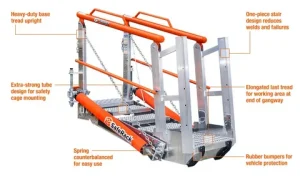
Global sales of rail gangway were reported at USD 494.3 million in 2020. Demand for railway gangway is anticipated to reach USD 560.4 million in 2025. Over the assessment period (2025 to 2035), the market is projected to expand at a CAGR of 4.8% and attain value of USD 720.1 million by the end of 2035.
The gangway or bridge is the connector between two adjacent rail cars that allow safe and easy movement. It ensures an easy transition from one car to another and safety during train operations, particularly in long trains, or in case of an emergency. With the strength of the durable gangways, passengers are protected from an accident from falling between cars. This feature would be of paramount importance for safe access and smooth working of trains where there are many carriages and on trains running during crowded conditions.
The global Rail Gangway Market is set to experience significant growth, driven by rapid urbanization, expansion of metro and high-speed rail projects, and technological innovations enhancing passenger safety and comfort. Rail gangways, essential components connecting train carriages, facilitate seamless passenger movement and contribute to the overall efficiency of rail transport systems.
Get Ahead with Our Report: Request Your Sample Now!
https://www.futuremarketinsights.com/report-sample#5245502d47422d35363832
Key Takeaways:
The market is projected to expand steadily over the coming years, primarily due to increasing investments in rail infrastructure and the modernization of rolling stock. This growth reflects the rising demand for efficient and sustainable public transportation solutions worldwide.
Key Drivers:
A significant driver of this market is the global trend toward urbanization, leading to increased demand for metro and high-speed rail networks. Additionally, technological advancements have led to the development of lightweight, flexible, and durable gangway systems that enhance passenger safety and comfort. The push for sustainable and eco-friendly transportation solutions further propels the adoption of advanced rail gangways.
Growth Opportunities:
Emerging economies, particularly in the Asia-Pacific region, present notable growth opportunities due to substantial investments in railway infrastructure and the expansion of urban transit systems. The adoption of lightweight materials and the integration of advanced safety features in gangway designs offer potential for market differentiation and increased adoption. Furthermore, the growing emphasis on passenger comfort and experience opens avenues for innovative gangway solutions.
Rail gangways are predominantly utilized in:
-
Passenger Trains: Enhancing connectivity and passenger movement between carriages in long-distance and commuter trains.
-
Metro and Subway Trains: Facilitating seamless transitions in urban transit systems, improving passenger flow and safety.
-
High-Speed Trains: Ensuring aerodynamic efficiency and passenger comfort in trains operating at elevated speeds.
Detailed Market Study: Full Report and Analysis
https://www.futuremarketinsights.com/reports/rail-gangways-market
Key Players:
-
HÜBNER GmbH & Co. KG
-
Dellner Couplers AB
-
Narita Mfg. Co., Ltd.
-
Wabtec Corporation
-
ATG AUTOTECHNIK GmbH
-
Kasper-Elektronik GmbH
-
HUTCHINSON
-
KTK Group
-
Chongqing Hengtairail Equipment Co., Ltd.
-
Airflow Equipments (India) Private Limited
Key Segmentation:
By Train Type:
- Passenger Train
- Metro and Subway Train
- High-Speed Train
- Special Train
By Product Type:
- Single Piece Gangways
- Two Piece Gangways
By Material:
- Aluminum
- Steel
- Composite Materials
By Region:
- North America
- Europe
- Asia-Pacific
- Latin America
- Middle East & Africa

